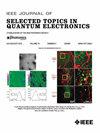基于发光二极管(LED)的弱光对自然杀伤细胞的生物学效应
IF 5.1
2区 工程技术
Q1 ENGINEERING, ELECTRICAL & ELECTRONIC
IEEE Journal of Selected Topics in Quantum Electronics
Pub Date : 2025-10-09
DOI:10.1109/JSTQE.2025.3619841
引用次数: 0
摘要
自然杀伤(NK)细胞作为一种很有前途的癌症免疫治疗策略,引起了人们的广泛关注,人们致力于提高其疗效。然而,尽管有各种方法可以增强NK细胞的功能,但仍然迫切需要更有效、更经济、更安全的方法。能量代谢在NK细胞的激活中起着至关重要的作用。低水平的光照会影响细胞能量代谢,从而影响细胞活动。在这项研究中,我们将低强度光应用于人源性NK-92细胞,以研究能量代谢改变引起的细胞活性变化。在能量密度为3 J/cm2的740 nm发光二极管(LED)下连续暴露3天,导致三磷酸腺苷(ATP)水平发生最显著的变化。此外,NK-92细胞以糖酵解依赖的方式产生ATP,暴露于740 nm光下进一步促进糖酵解过程。740 nm光刺激可抑制NK-92细胞凋亡,增强细胞毒性。综上所述,这些发现表明基于led的弱光疗法是一种增强NK细胞功效的可行方法。本文章由计算机程序翻译,如有差异,请以英文原文为准。
Biological Effects of Light-Emitting Diode (LED)-Based Low-Level Light on Natural Killer Cells
Natural killer (NK) cells have attracted considerable attention as a promising strategy for cancer immunotherapy, leading to research efforts aimed at enhancing their efficacy. However, despite the availability of various approaches to enhance NK cell function, there remains an urgent need for more efficient, cost-effective, and safe methods. Energy metabolism plays a critical role in the activation of NK cells. Low levels of light can influence cellular energy metabolism, thereby affecting cellular activity. In this study, we applied low-level light to human-derived NK-92 cells to investigate the changes in cellular activity induced by alterations in energy metabolism. Exposure to a 740 nm light-emitting diode (LED) at an energy density of 3 J/cm2 once daily for 3 consecutive days resulted in the most significant changes in adenosine triphosphate (ATP) levels. Furthermore, NK-92 cells produced ATP in a glycolysis-dependent manner, and exposure to 740 nm light further promoted the glycolytic process. Additionally, 740 nm light stimulation prevented apoptosis in cells and enhanced the cytotoxicity of NK-92 cells. In conclusion, these findings suggest that LED-based low level light therapy is a viable approach for enhancing the efficacy of NK cells.
求助全文
通过发布文献求助,成功后即可免费获取论文全文。
去求助
来源期刊

IEEE Journal of Selected Topics in Quantum Electronics
工程技术-工程:电子与电气
CiteScore
10.60
自引率
2.00%
发文量
212
审稿时长
3 months
期刊介绍:
Papers published in the IEEE Journal of Selected Topics in Quantum Electronics fall within the broad field of science and technology of quantum electronics of a device, subsystem, or system-oriented nature. Each issue is devoted to a specific topic within this broad spectrum. Announcements of the topical areas planned for future issues, along with deadlines for receipt of manuscripts, are published in this Journal and in the IEEE Journal of Quantum Electronics. Generally, the scope of manuscripts appropriate to this Journal is the same as that for the IEEE Journal of Quantum Electronics. Manuscripts are published that report original theoretical and/or experimental research results that advance the scientific and technological base of quantum electronics devices, systems, or applications. The Journal is dedicated toward publishing research results that advance the state of the art or add to the understanding of the generation, amplification, modulation, detection, waveguiding, or propagation characteristics of coherent electromagnetic radiation having sub-millimeter and shorter wavelengths. In order to be suitable for publication in this Journal, the content of manuscripts concerned with subject-related research must have a potential impact on advancing the technological base of quantum electronic devices, systems, and/or applications. Potential authors of subject-related research have the responsibility of pointing out this potential impact. System-oriented manuscripts must be concerned with systems that perform a function previously unavailable or that outperform previously established systems that did not use quantum electronic components or concepts. Tutorial and review papers are by invitation only.
 求助内容:
求助内容: 应助结果提醒方式:
应助结果提醒方式:


